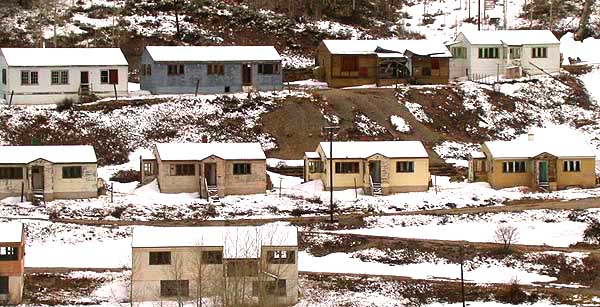Gilman is an abandoned mining town in Eagle County, Colorado founded in 1886 during the Colorado Silver Boom. Scattered mining operations sprouted along Battle Mountain in 1879, which is the official year the Colorado Silver Boom started. The town of Gilman and larger scale operations were developed in the early 1880s. The architect, so to say, of the town and the operation was John Clinton, a judge, prospector, and speculator from the nearby town of Red Cliff. The town sits at 8950 ft (2,000 meters) on a scenic 600-foot cliff above Eagle River. Located north of Tennessee Pass and southeast of Minturn, the remains of the town can be seen from many curves along Highway 24.

In the 1880s John Clinton acquired numerous mining operations in the area, among them the profitable Iron Mask with it’s many caverns and crystal formations. Clinton developed the town of Gilman in the vicinity and greatly improved the mining operations which brought higher capitalization. The town itself, which in the first days was nothing more than a camp for the miners to sleep in, was initially named after him. He donated money for a school to be built and added to it a boarding house.

By 1882, the Denver and Rio Grande Railroad reached the Belden mining district. In 1887 two vertical chimneys of gold and silver were discovered at the Ground Hog Mine, and gold and silver didn’t stop coming out of it until the 1920s. This was great news that attracted many prospectors and by 1899 the town had population of around 300 people, as well as it’s own newspaper called Gilman Enterprise.


The mining district in no time became the richest and most successful in the whole of Eagle County. Ore was found in sulfide replacement deposits of three types: thin-bedded deposits in the Sawatch Quartzite, highly elongated ore bodies in the Leadville Limestone, and vertical pipes or chimneys cutting across the various formations. The most often found ore minerals were sphalerite, chalcopyrite, and galena. Also, non-ore minerals like pyrite and siderite were abundant in the ore bodies. As the mining went on and the miners reached deeper primary sulfide ores, they found that the ore contained a lot more zinc than before.

So much more in fact that smelters refused to buy the ore. This called for further expansion of the mine’s technology. A roaster and magnetic separator were installed in 1905 to separate out the zinc minerals and thus turning the problem into another source of profit. Transition to zinc came naturally even though Eagle Mine was the leader in producing silver in the whole state in 1930.


In 1912 the New Jersey Zinc Company entered Gilman and in the period of the next several years bought all the principal mines and eventually the entire township. Zinc was mined until 1930 when the company was forced to switch to mining the pretty much ending reserves of copper-silver ore due to low zinc prices.

However, zinc mining and production resumed in 1941 and once again it was the principal product of the mines until they were closed in the 1980s. Around the 1960s the town had its own grocery store, infirmary, and a bowling alley, and the population continued to steadily rise. In 1970 the total production of the mines exceeded 10 million tons of ore. Out of which came 393,000 troy ounces of gold, 66,000,000 troy ounces of silver, 105,000 tons of copper, 148,000 tons of lead and 858,000 tons of zinc.

The town was abandoned in 1984 by direct order of the Environmental Protection Agency due to toxic pollutants and contamination of ground water. To add to that, the mines started to become unprofitable. After their closure and the abandonment of the town a 235 acre area was designated a Superfund site by the Environmental Protection Agency and placed on the National Priorities List in 1986. This includes the clean up of 8 million tons of dumped mine waste. Some plans of building a winter ski resort were considered after 2007, but for now they still remain only as plans.
